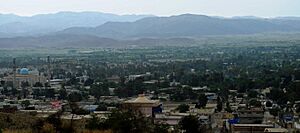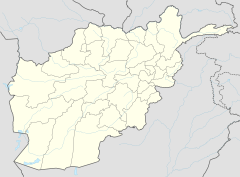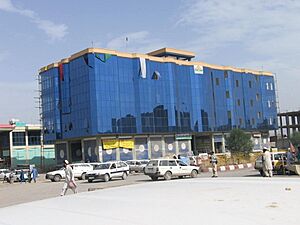Khost facts for kids
Quick facts for kids
Khost
خوست
|
|
|---|---|
|
City
|
|

View in Khost, Afghanistan
|
|
| Country | |
| Province | Khost |
| District | Khost |
| Government | |
| • Type | Municipality |
| Elevation | 1,225 m (4,019 ft) |
| Population
(2006)
|
|
| • City | 160,214 |
| • Urban | 106,083 |
| Time zone | UTC+04:30 (AFT) |
| Postal code |
25XX
|
Khost (Pashto: خوست) is an important city in Afghanistan. It is the capital of Khost Province. Khost is the biggest city in southeastern Afghanistan. It is also the largest city in the Loya Paktia region. To the south and east, Khost is close to Waziristan and Kurram in Pakistan. The city is home to Shaikh Zayed University and the Khost Airport.
Contents
Geography of Khost
Khost is located about 150 kilometers (93 miles) south of Kabul, Afghanistan's capital. The city sits on a high flat area called a plateau. This plateau is about 1,000 meters (3,280 feet) above sea level. It stretches east for about 40 kilometers (25 miles) to the border with Pakistan.
To the north, mountains rise very high, between 2,500 and 3,000 meters (8,200 to 9,800 feet). South of Khost, about 20 kilometers (12 miles) from the border, the land is around 1,800 meters (5,900 feet) high.
Khost's Climate
Khost has a semi-arid climate. This means it's usually dry, but not a complete desert. It's located in a "Khost Bowl," which is a valley lower than the mountains around it. This helps Khost have milder weather.
Winters in Khost are noticeably milder than in the colder, snowy towns nearby. The average temperature in January is about 4.8°C (40.6°F). However, it can still get cold enough for frost in the early mornings.
Unlike most of Afghanistan, Khost gets a lot of its rain from the South Asian monsoon. This happens because the valley is open to the southeast. Moisture-filled winds bring welcome rain during the summer. The rest of the year, Khost is hot and dry. Sometimes, there are droughts if the summer monsoon doesn't bring enough rain.
Land Use in Khost
Khost is the main administrative center for its province in eastern Afghanistan. It is also an important transport route because it is close to the border with Pakistan. The eastern parts of the city have forests and homes. The western parts are drier and have fewer people. About 5% of the land in Khost is covered by water.
History of Khost
Khost in the 19th and 20th Centuries
During the Second Anglo-Afghan War, British forces entered Khost. This was part of the second British invasion of Afghanistan. About 8,000 fighters from the Mangal tribe attacked British supply convoys in Khost. This tribe had a long history of fighting against outside control.
In response, the British commander, Lord Roberts, ordered his forces to attack eleven Mangal villages. These villages had been involved in raids that killed several people who followed the army. When people in Britain heard about these actions, some politicians criticized Lord Roberts. After the war ended, British forces left Khost.
Khost Rebellions
Between 1856 and 1925, Khost was the site of three rebellions. These uprisings happened in 1856–1857, 1912, and 1924–1925.
During the Soviet–Afghan War, Khost was under a long siege. This siege lasted for more than eight years. Soon after Soviet troops invaded Afghanistan, Afghan fighters, known as guerillas, took control of the only land route to Khost. This stopped the Soviet army from advancing.
The Soviets used the Khost Airfield as a base during an attack on a cave complex called Zhawar Kili. They used helicopters to bring troops into the battle area.
By April 1995, the city of Khost was controlled by the Taliban.
Khost in the 21st Century
During the war in Afghanistan (2001–2021), the United States built a base called Forward Operating Base Chapman near Khost. Because of its location, Khost was a place where insurgent groups were very active. They tried to fight against the American forces there.
Like many other provinces, Khost had both military forces and a Provincial Reconstruction Team (PRT). The military forces fought against insurgents and helped the Afghan National Army and Afghan National Police. The PRT focused on rebuilding and improving the area.
In 2007, a US Army officer named Lieutenant Colonel Scottie Custer decided to send paratroopers to different district centers in Khost. These soldiers protected government buildings and were visible in towns. They also helped train Afghan National Army and Police units.
These protection facilities helped bring more safety and growth to the areas around them. New markets, shops, and gas stations made life better for local people. For example, the Mandozai facility in Khost included a medical clinic. This helped Afghans get basic medical care. People also started going to the sub-governors' offices to solve problems instead of using older, sometimes unfair, tribal methods.
Throughout 2007 and 2008, roads were improved, and new businesses opened. Many schools were built, with 50 in 2007 and 25 more planned for 2008. A new airport was also being built, as the Khost Airfield was used by the US Military. This created new opportunities and jobs. The Provincial Reconstruction Team helped connect people to the government in Khost City. They spent over $2.5 million on community projects.
On August 15, 2021, Taliban fighters took control of Khost. This made it the twenty-eighth provincial capital to be captured by the Taliban during their 2021 offensive.
In June 2022, a strong earthquake hit Afghanistan. At least 29 people died in Khost during this earthquake.
People of Khost (Demographics)

The city of Khost has an urban population of about 106,083 people (as of 2015). Most of these people are Pashtuns. They belong to various tribes like Zadran, Mangal, Zazi, and others. These people live in about 11,787 homes across six city districts.
The wider Khost province had about 511,600 people in 2008. There are about 87,199 households, with an average of eight people living in each home. Most of the population (98%) lives in rural areas. Pashtuns are the largest ethnic group in the province. Many different Pashtun tribes live here, including Zadran, Mangal, and Mandozi. There is also a small group of Pamiris.
Some people in Khost province are Kuchis, who are nomads. Their numbers change depending on the season. Many Kuchis travel long distances between their winter and summer homes.
Sports in Khost
The three most popular sports in Khost are cricket (86%), basketball (19%), and football (11%).
Cricket is becoming very popular in Khost. Many refugees returning from Pakistan helped introduce the sport. Several famous Afghan cricketers are from Khost. These include Mujeeb Ur Rahman, a spinner, and Noor Ali, a batsman. Nawroz Mangal, a former captain of the Afghanistan Cricket Team, is also from Khost. Dawlat Zadran, an Afghan cricket bowler, who took important wickets against Pakistan, is also from Khost.
In football, the team representing Khost and its surrounding region is De Abasin Sape F.C.. They play in the Afghan Premier League.
- Professional Sports Teams from Khost
| Club | League | Sport | Venue | Established |
|---|---|---|---|---|
| Paktia Panthers | Afghanistan Premier League | Cricket | Sharjah Cricket Stadium | 2018 |
| Mis Ainak Knights | Shpageeza Cricket League | Cricket | Khost Cricket Stadium | 2013 |
| De Abasin Sape F.C. | Afghan Premier League | Football | Khost City Ground | 2012 |
Stadiums in Khost
- Khost Cricket Stadium: This stadium was built with money from Germany. When it opened, a cricket match was played, and a record number of people came to watch.
- Khost City Ground: This is a stadium in Khost used for football and other sports.
Economy of Khost
Khost is an important trading center for Afghanistan with neighboring Pakistan. The Ghulam Khan border crossing, which is a key point for trade, is about 20 miles (32 km) south of Khost.
Pine nuts are one of the important products that Khost province exports to other places.
Notable Sport Players
- Nawroz Mangal
- Noor Ali Zadran
- Mujeeb Zadran
- Rahmanullah Gurbaz
- Fazal Niazai
- Ibrahim Zadran
- Dawlat Zadran
- Noor Ahmad
See also
 In Spanish: Jost para niños
In Spanish: Jost para niños



